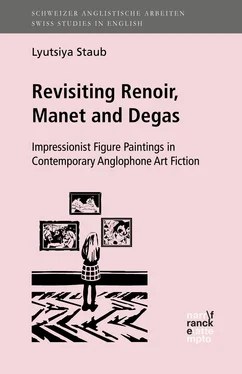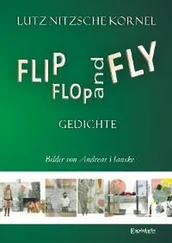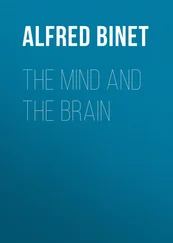Lyutsiya Staub - Revisiting Renoir, Manet and Degas
Здесь есть возможность читать онлайн «Lyutsiya Staub - Revisiting Renoir, Manet and Degas» — ознакомительный отрывок электронной книги совершенно бесплатно, а после прочтения отрывка купить полную версию. В некоторых случаях можно слушать аудио, скачать через торрент в формате fb2 и присутствует краткое содержание. Жанр: unrecognised, на английском языке. Описание произведения, (предисловие) а так же отзывы посетителей доступны на портале библиотеки ЛибКат.
- Название:Revisiting Renoir, Manet and Degas
- Автор:
- Жанр:
- Год:неизвестен
- ISBN:нет данных
- Рейтинг книги:4 / 5. Голосов: 1
-
Избранное:Добавить в избранное
- Отзывы:
-
Ваша оценка:
- 80
- 1
- 2
- 3
- 4
- 5
Revisiting Renoir, Manet and Degas: краткое содержание, описание и аннотация
Предлагаем к чтению аннотацию, описание, краткое содержание или предисловие (зависит от того, что написал сам автор книги «Revisiting Renoir, Manet and Degas»). Если вы не нашли необходимую информацию о книге — напишите в комментариях, мы постараемся отыскать её.
Revisiting Renoir, Manet and Degas — читать онлайн ознакомительный отрывок
Ниже представлен текст книги, разбитый по страницам. Система сохранения места последней прочитанной страницы, позволяет с удобством читать онлайн бесплатно книгу «Revisiting Renoir, Manet and Degas», без необходимости каждый раз заново искать на чём Вы остановились. Поставьте закладку, и сможете в любой момент перейти на страницу, на которой закончили чтение.
Интервал:
Закладка:
The witness reads a literary text from page to page over time. But his understanding is ideally not complete until he “sees” the work as a whole, as if spatialized in his mind as a simultaneous pattern of significance. […] This pattern may be thematic, formal, psychological, or a combination of these or other elements; it may take shape before he has finished the book, or perhaps not before he has read it many times; it will certainly grow richer and more clearly defined through re-reading. (10)
The experience of a painting is further clarified:
The witness sees the painting as a pattern but he does not understand it fully until he “reads” it […] moving from one detail to another over time […] perceiving the interrelationships of light, color, form, gesture, surface, space, point of view, and so on. The order of experience in painting (seeing first, then “reading”) is superficially the reverse of the literary experience, except that the final painting which, having been seen and “read” is finally known, is no longer identical with the square of canvas we happened to notice when we first walked into the room. (11)
The main argument is that neither a narrative text nor a painting can be completely understood and further interpreted unless both are seen or read as a whole, perceived through their details and/or parts and, finally, re-seen/re-read and re-interpreted. Gilman’s point is of great value to this study as it is based on the idea of a perception of a whole that is acquired through the study of its parts, and thus becomes a springboard for analyses of the re-interpretation of paintings in contemporary art fiction. According to Arnheim, visual perception is in fact visual thinking ( Visual Thinking 14); it is not only concerned with collecting information about specific objects, their qualities and the events happening, but also with the understanding of the general ideas expressed, which plays a significant role in concept formation:
The mind, reaching far beyond the stimuli received by the eyes directly and momentarily, operates with the vast range of imagery available through memory and organizes a total lifetime’s experience into a system of visual concepts. The thought mechanism by which the mind manipulates these concepts operate in direct perception, but also in the interaction between direct perception and stored experience, as well as in the imagination of the artist, the scientist, and indeed any person handling problems “in his head”. (294)
What is suggested here is that visual perception is conditioned by the viewer’s stored personal experience. The aesthetic experience of looking at a painting does incite an emotional response from the viewer. However, this emotional reaction is not the result of what Tolstoy defines as the activity of art: “To evoke in oneself a feeling one has once experienced and having evoked it in oneself then by means of movements, lines, colours, sounds, or forms expressed in words, so to transmit that feeling that others experience the same feeling” (123). The works of art do not express or transmit emotions; emotions are not the “content of a work of art but only a secondary effect of the content” (Arnheim, Visual Thinking 21). The viewer is not influenced by the same feelings as the painter was while creating an artwork – the viewer’s emotional response to a work of art is based singularly on his/her own experience, cultural education and imagination. Panofsky defines a work of art as “a man-made object demanding to be experienced aesthetically” (14). He further claims that:
Anyone confronted with a work of art, whether aesthetically re-creating or rationally investigating it, is affected by its three constituents: materialized form, idea (that is, in the plastic arts, subject matter) and content. […] It is the unity of those three elements which is realized in the aesthetic experience, and all of them enter into what is called aesthetic enjoyment of art. (16)
An artwork is re-created in accordance with the painter’s supposedly original intention and the viewer’s set of aesthetic values as well as his/her “natural sensitivity”, “visual training” and “cultural equipment” (Panofsky 16). Therefore, the perception of an artwork is never as objective as while investigating it and re-creating its meaning, which already embodies one way of seeing: the perceiver, depending on his/her way of seeing, inevitably adds his/her own interpretation and extends its meaning according to his/her subjectivity. As our attention is selective, we choose which details to notice, which to pay less attention to, and which to ignore altogether. The perceiver of the painting is unlikely to embrace the visual image as a whole immediately. The totality of the meaning conveyed by the painting has to be fragmented into scenes, elements and/or details. Barthes points out that every image is polysemic (39) and that the basis of its signifiers is a “floating chain” (39) of signifieds. In order to interpret the painting the perceiver selects and concentrates on just a few of its signifieds. The choice of pictorial elements is individual, inevitably differing from the choice made by other perceivers of the same painting. Therefore, there is no one interpretation of a painting, but rather many – each of them depends on the observer’s choice of pictorial elements and his/her understanding of them. According to Arnheim, a verbal description of a painting
traces linear connections across the state of affairs and presents each of these partial relations as a one-dimensional sequence of events. More importantly, it presents these sequences in a meaningful order, starting perhaps with a particularly significant or evocative detail and making the facets of the situation to follow each other as though they were the steps of an argument. The description of the scene becomes an interpretation. The writer uses the idiosyncrasies of his medium to guide the reader through a scene, just as a film can move the viewer from detail to detail and thereby reveal a situation by a controlled sequence. ( Visual Thinking 248)
The effect of guiding or directing the reader through the maze of details in the painting – and their possible meanings – corresponds to a function of the text which Barthes calls anchorage (39). Anchorage occurs when “the text directs the reader through the signifieds of the image, causing him to avoid some and receive others; by means of an often dispatching , it remote-controls him towards a meaning chosen in advance” (40, emphasis in original). According to Barthes, the text is “the creator’s […] right of inspection over the image; anchorage is a control, bearing responsibility […] for the use of the message” (40). However, Barthes distinguishes another function of the text, which he calls relay (41). Relay text creates new meanings that are not originally present in the image itself. Text and image have a “complementary relationship” and work towards conveying the intended meaning. This differentiation can be applied to the word-image relationship in ekphrastic texts. On the one hand, the writer directs the reader through the painting, focusing on pictorial elements chosen in advance, thus controlling the reader’s understanding and interpretation of the painting. On the other, the writer assigns new meanings to the painting by fictionalising the process of its creation. Regarding the practice of ekphrasis, it is safe to assume that the writer is the perceiver who, in order to create a verbal interpretation of a painting, takes on the role of an art historian, and re-constructs the work of art through a synthesis of signifieds of selected pictorial elements of a painting, through the available knowledge of an artwork – its historical, cultural and critical analysis – and his/her own perception, subjective evaluation and interpretation of the work of art, which in due turn, depend upon the writer-perceiver’s personal experience, cultural education, learnt assumptions about art and imagination. The most common feature of contemporary art fiction, therefore, is the fact that written works function as both anchorage and relay texts that create new meanings inside and outside an artwork. Ekphrastic re-presentation is tested on the reader-perceiver, who is encouraged not only to envision the work of art based on the writer’s markers and allusions to the visual source, but also to translate the re-interpretation of it according to his/her emotional response to the painting and the ekphrastic text itself through his/her cognitive reactions to the fictitious story narrated around the work of art. Therefore, when analysing an intermedial artefact, the following questions are bound to arise: What knowledge of an artwork is applied, extended or denied? Can an artwork be re-represented in a meaningful way? Can aesthetic appreciation of an artwork be offered? Can the narrative reveal the painting? What happens if a reproduction of a painting is included in the text? How will the viewer’s and reader’s reaction to a work of art differ? Can the narrative be considered a valid guide to a painting? Can an intermedial artefact be regarded as a fictional art manual? In order to answer any of the above questions or to find a way to justify verbal re-presentation of visual representation, it is necessary to analyse how something intrinsically visual is embedded into a verbal form. A writer is entirely free when it comes to choosing the type of relationship that exists between the verbal and the visual, yet the way in which an art object is translated narratively is directly connected to the message it seeks to convey in a new medium, and to the effect it has on the reader. This study offers a classification for intermedial interaction, which can be applied to the analysis of contemporary intermedial products. It focuses on how an artwork is incorporated, re-presented and re-interpreted in contemporary Anglophone art fiction.
Читать дальшеИнтервал:
Закладка:
Похожие книги на «Revisiting Renoir, Manet and Degas»
Представляем Вашему вниманию похожие книги на «Revisiting Renoir, Manet and Degas» списком для выбора. Мы отобрали схожую по названию и смыслу литературу в надежде предоставить читателям больше вариантов отыскать новые, интересные, ещё непрочитанные произведения.
Обсуждение, отзывы о книге «Revisiting Renoir, Manet and Degas» и просто собственные мнения читателей. Оставьте ваши комментарии, напишите, что Вы думаете о произведении, его смысле или главных героях. Укажите что конкретно понравилось, а что нет, и почему Вы так считаете.












